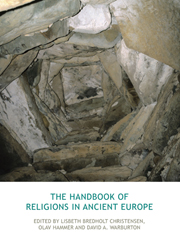Book contents
- Frontmatter
- Contents
- A note on Greek and Latin sources
- Abbreviations and short titles
- 1 Introduction
- PART I PREHISTORIC RELIGIONS
- 2 Studying prehistoric religions
- 3 Prehistoric material and religion: a personal odyssey
- 4 Francesco d'Errico and the origins of religion
- 5 On Palaeolithic religion
- 6 Ian Hodder and the Neolithic
- 7 Neolithic cult images? The testimony of figurines for Neolithic religion
- 8 Religious practices in northern Europe 4000–2000 BCE
- 9 Mythological aspects of Nordic Bronze Age religion
- 10 Religion and society in the Bronze Age
- 11 The religions of prehistoric Europe and the study of prehistoric religion
- PART II ANCIENT EUROPE IN THE HISTORICAL PERIOD
- Timeline of key dates
- Contributors
- References
- Index
7 - Neolithic cult images? The testimony of figurines for Neolithic religion
from PART I - PREHISTORIC RELIGIONS
- Frontmatter
- Contents
- A note on Greek and Latin sources
- Abbreviations and short titles
- 1 Introduction
- PART I PREHISTORIC RELIGIONS
- 2 Studying prehistoric religions
- 3 Prehistoric material and religion: a personal odyssey
- 4 Francesco d'Errico and the origins of religion
- 5 On Palaeolithic religion
- 6 Ian Hodder and the Neolithic
- 7 Neolithic cult images? The testimony of figurines for Neolithic religion
- 8 Religious practices in northern Europe 4000–2000 BCE
- 9 Mythological aspects of Nordic Bronze Age religion
- 10 Religion and society in the Bronze Age
- 11 The religions of prehistoric Europe and the study of prehistoric religion
- PART II ANCIENT EUROPE IN THE HISTORICAL PERIOD
- Timeline of key dates
- Contributors
- References
- Index
Summary
In dealing with archaeological materials, some fundamental differences distinguish the study of religion from other archaeological sub-disciplines, such as subsistence, trade or social structures. Observations on religion involve far more interpretation of the sources than any of the other types of enquiry (Hawkes 1954).
As a first step we must address the question of which prehistoric sources can serve for the study of religion. Small clay figures of humans and animals could, for example, play a role; but they may also have been merely mundane children's toys (Winiger 1981). The ultimate scientific explanation favouring the one or the other view has not yet been produced. The next step is to explain just what kind of religious representation is involved (Petrasch 2002). This is easy enough in the case of classical Greece, where the spectrum of religious images ranged from cult images in temples through funerary monuments (kouroi), sculptured pillars (hermai), and bronze and marble statues of gods, which could be displayed virtually anywhere in public or private places, including coins where Zeus's head was depicted. Another interpretive step is the attempt to classify the motif of the religious representation and to identify the meaning for the original user. In this fashion, European Neolithic clay figurines have been viewed as images of gods, ancestors, priests or praying individuals, or as substitutes for human sacrifices (Ucko 1968; Höckmann 2000–2001; Hansen 2007: 319–45). Attempts have also occasionally been made to identify the particular deity depicted by any given type of statue (Gimbutas 1989).
- Type
- Chapter
- Information
- The Handbook of Religions in Ancient Europe , pp. 53 - 62Publisher: Acumen PublishingPrint publication year: 2013



